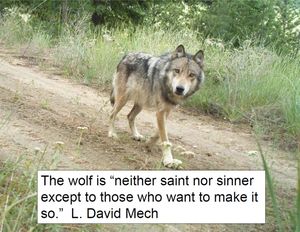Wolves are back, thriving; Spending millions no longer necessary
PREDATORS -- Wolves have made a resounding comeback in Idaho and Montana and they're essentially recovered in Oregon and Washington. It's time to quit spending so much money on needlessly counting, monitoring and managing them. The money would be better spent improving habitat for their prey.
Wolves are here to stay, and a wolf pack that has plenty of deer and elk is a healthy pack that's more likely to avoid conflict with people and livestock.
All of those statements are collaborated by the experience wolf managers have accumulated in the past 20 years.
My Sunday story, "Costly Critter," helps put into perspective the millions of dollars states are spending on wolf recovery.
Two quotes from that story are important to Washington as it pushes forward to "official" recovery. The insight comes from Idaho and Montana where delisting has occurred.
These two quotes help us understand that wolves MUST be managed in order to fit into society. In the bigger picture, wolves must be "normalized" so they're respected but managed and treated like other wildlife.
That means environmental groups will have to let go of their cash cow and quit crying wolf ($$$) every time a protocol suggests that some of the predators need to be killed.
These quotes are food for thought:
Todd Grimm, director of the U.S. Department of Agriculture’s Wildlife Services Program for Idaho:
“Other predators are not even in the same league in terms of damage complaints.
“Idaho has around 20,000 black bears and 2,500 mountain lions. They’re of similar size to wolves, occupying roughly the same space, yet those two species cause very little conflict in terms of livestock compared with wolves.
“Idaho probably spends less than $10,000 dealing with depredation by bears and cougars. Last year, $576,357 was spent dealing with wolf depredation.”
Bob Inman, Montana Fish, Wildlife and Parks Department carnivore and furbearer coordinator:
“One thing about wolves, they’re prolific. It’s hard to overdo management actions. They’re resilient and people have gotten more used to them being around.
“Wolves definitely have arrived as a cost that wasn’t out here in the previous100 years. It’s definitely not going away, but it doesn’t have to be so high.”
Jim Hayden, Idaho Fish and Game's wolf manager, offers plenty of details in "Costly Critter" to support the concept of dramatically curbing wolf management spending. See the story.
Washington wildlife managers already have been bringing this discussion to the table. At the state Fish and Wildlife Commission meeting on Feb. 10, Fish and Wildlife Department wolf managers gave an hour-long presentation on wolf management. The discussion that followed involving Fish and Wildlife commissioners included concepts for normalizing wolves.
The audio of that Science Panel-Wolf Advisory Group presentation and discussion is available from the commission's agenda page.
Or check out the pertinent quotes from the discussion on this and other wolf topics rounded up in the Editor's Blog by Andy Walgamot of Northwest Sportsman.

